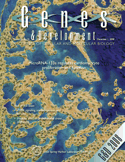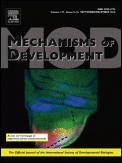Cell Cycle is a biweekly peer-reviewed scientific journal covering all aspects of cell biology. It was established in 2002 with Mikhail V. Blagosklonny as founding editor-in-chief. Originally published bimonthly, it is now published biweekly.

BioEssays is a monthly peer-reviewed review journal covering molecular and cellular biology. Areas covered include genetics, genomics, epigenetics, evolution, developmental biology, neuroscience, human biology, physiology, systems biology, and plant biology. The journal also publishes commentaries on aspects of science communication, education, policy, and current affairs.

Developmental Biology is a peer-reviewed scientific journal. It was established in 1959 and is the official journal of the Society for Developmental Biology. It publishes research on the mechanisms of development, differentiation, and growth in animals and plants at the molecular, cellular, and genetic levels. The journal is published twice a month by Elsevier.

Cell is a peer-reviewed scientific journal publishing research papers across a broad range of disciplines within the life sciences. Areas covered include molecular biology, cell biology, systems biology, stem cells, developmental biology, genetics and genomics, proteomics, cancer research, immunology, neuroscience, structural biology, microbiology, virology, physiology, biophysics, and computational biology. The journal was established in 1974 by Benjamin Lewin and is published twice monthly by Cell Press, an imprint of Elsevier.
Within the field of developmental biology, one goal is to understand how a particular cell develops into a final cell type, known as fate determination. Within an embryo, several processes play out at the cellular and tissue level to create an organism. These processes include cell proliferation, differentiation, cellular movement and programmed cell death. Each cell in an embryo receives molecular signals from neighboring cells in the form of proteins, RNAs and even surface interactions. Almost all animals undergo a similar sequence of events during very early development, a conserved process known as embryogenesis. During embryogenesis, cells exist in three germ layers, and undergo gastrulation. While embryogenesis has been studied for more than a century, it was only recently that scientists discovered that a basic set of the same proteins and mRNAs are involved in embryogenesis. Evolutionary conservation is one of the reasons that model systems such as the fly, the mouse, and other organisms are used as models to study embryogenesis and developmental biology. Studying model organisms provides information relevant to other animals, including humans. While studying the different model systems, cells fate was discovered to be determined via multiple ways, two of which are by the combination of transcription factors the cells have and by the cell-cell interaction. Cells’ fate determination mechanisms were categorized into three different types, autonomously specified cells, conditionally specified cells, or syncytial specified cells. Furthermore, the cells’ fate was determined mainly using two types of experiments, cell ablation and transplantation. The results obtained from these experiments, helped in identifying the fate of the examined cells.

Microbiology is a monthly peer-reviewed scientific journal that covers research in all aspects of microbiology, including the biochemistry, cell biology, molecular biology, developmental biology, physiology, pathogenicity, biodiversity, biotechnology, evolution, and genetics of microorganisms and their viruses. It also covers plant-microbe interactions, and environmental and theoretical microbiology. The journal is published monthly by the Microbiology Society. It was established in January 1947 as the Journal of General Microbiology and obtained its current name in 1994. Since 2020, the editor-in-chief is Gavin H. Thomas, who took over from Tanya Parish, who served since 2015. The microbiologist and science writer Sir John Postgate FRS was editor from 1969 to 1974.

Current Biology is a biweekly peer-reviewed scientific journal that covers all areas of biology, especially molecular biology, cell biology, genetics, neurobiology, ecology, and evolutionary biology. The journal includes research articles, various types of review articles, as well as an editorial magazine section. The journal was established in 1991 by the Current Science group, acquired by Elsevier in 1998 and has since 2001 been part of Cell Press, a subdivision of Elsevier. According to Journal Citation Reports, the journal has a 2020 impact factor of 10.834. It was categorized as a "high impact journal" by the Superfund Research Program.

The Annual Review of Cell and Developmental Biology is a peer-reviewed scientific journal published by Annual Reviews since 1985. It releases an annual volume of review articles relevant to the fields of cell biology and developmental biology. Its editor has been Ruth Lehmann since 2018; as of 2022, its impact factor is 11.902. As of 2023, Annual Review of Cell and Developmental Biology is being published as open access, under the Subscribe to Open model.
Cell Press is an all-science publisher of over 50 scientific journals across the life, physical, earth, and health sciences, both independently and in partnership with scientific societies. Many of Cell Press's journals are among the most reputable in their fields. Cell Press was founded and is currently based in Cambridge, MA, and has offices across the United States, Europe, and Asia under its parent company Elsevier.

Genes & Development is a peer-reviewed scientific journal covering molecular biology, molecular genetics, cell biology, and development. It was established in 1987 and is published twice monthly by Cold Spring Harbor Laboratory Press in association with The Genetics Society.
Reproduction is a monthly peer-reviewed medical journal covering the cellular and molecular biology of reproduction, including the development of gametes and early embryos in all species; developmental processes such as cell differentiation, morphogenesis and related regulatory mechanisms in normal and disease models, assisted reproductive technologies in model systems and in a clinical environment, and reproductive endocrinology, immunology and physiology. Emerging topics including cloning, the biology of embryonic stem cells, environmental effects on reproductive potential and health, and epigenetic effects on reproductive and developmental processes are also covered. All editorial and review content is free to access from publication; research articles become available after 12 months.
Reproduction, Fertility and Development is an international peer-reviewed scientific journal published by CSIRO Publishing. The journal publishes original and significant contributions on vertebrate reproductive and developmental biology. Subject areas include, but are not limited to: physiology, biochemistry, cell and molecular biology, endocrinology, genetics and epigenetics, behaviour, immunology and the development of reproductive technologies in humans, livestock and wildlife, and in pest management.

Mechanisms of Development is a peer-reviewed scientific journal covering all aspects of developmental biology. It is the official journal of the International Society of Developmental Biologists and is published by Elsevier. The journal was established in 1972 as Cell Differentiation and was renamed Cell Differentiation and Development in 1988. It acquired its current name in December 1990. The editor-in-chief is D. Wilkinson. A separate section of the journal, Gene Expression Patterns, covers research on cloning and gene expression. In 2020 the journal became Cells & Development with the subtitle: 'Cell and Developmental Biology and their Quantitative Approaches'.

Genesis: The Journal of Genetics and Development is a peer-reviewed scientific journal of genetics and developmental biology. It was established as Developmental Genetics in 1979 and obtained its current title in 2000. In addition to original research articles, the journal also publishes letters to the editor and technology reports relevant to the understanding of the functions of genes. The editor-in-chief is Sally A. Moody.
The Journal of Visualized Experiments is a peer-reviewed scientific journal that publishes experimental methods in video format. The journal is based in Cambridge, MA and was established in December 2006. Moshe Pritsker is the CEO and co-founder.

Elizabeth Jane Robertson is a British developmental biologist based at the Sir William Dunn School of Pathology, University of Oxford. She is Professor of Developmental Biology at Oxford and a Wellcome Trust Principal Research Fellow. She is best known for her pioneering work in developmental genetics, showing that genetic mutations could be introduced into the mouse germ line by using genetically altered embryonic stem cells. This discovery opened up a major field of experimentation for biologists and clinicians.

Hossein Baharvand is an Iranian stem cell and developmental biologist. He received his B.Sc. in biology from Shiraz University in 1994, and M.Sc. in Developmental Biology from Shahid Beheshti University, Tehran in 1996. He then obtained his Ph.D. in Cell and Developmental Biology from Khwarizmi University in 2004. He first joined the Royan Institute in 1995 in which he founded Royan Institute for Stem Cell Biology and Technology.
IUBMB Life is a peer-reviewed scientific journal of developmental biology that was established in 1999. It is one of four official journals of the IUBMB. The journal is published monthly by John Wiley & Sons.

In Vitro Cellular & Developmental Biology is a peer-reviewed scientific journal covering all aspects of in vitro biology. It was originally established as In Vitro in 1965, acquiring its current name in 1983. In 1991, In Vitro Cellular & Developmental Biology – Plant was created, with the original section renaming itself In Vitro Cellular & Developmental Biology – Animal in 1993. The journals are published by Springer Science+Business Media on behalf of the Society for In Vitro Biology.











